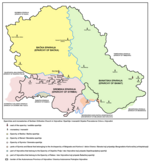City Park, Zemun
Parks in BelgradeZemun

City Park or Zemun Park (Serbian: Градски парк у Земуну / Земунски парк) is a park in Zemun, a neighborhood of Belgrade, the capital of Serbia. Located on the rim of the Old Core of Zemun, it is considered today as one of the symbols of Zemun and one of the most beautiful parks in Belgrade.
Excerpt from the Wikipedia article City Park, Zemun (License: CC BY-SA 3.0, Authors, Images).City Park, Zemun
Градски парк, Zemun Urban Municipality Zemun
Geographical coordinates (GPS) Address Nearby Places Show on map
Geographical coordinates (GPS)
| Latitude | Longitude |
|---|---|
| N 44.840842 ° | E 20.408962 ° |
Address
Бомбаш
Градски парк
11000 Zemun Urban Municipality, Zemun
Central Serbia, Serbia
Open on Google Maps









